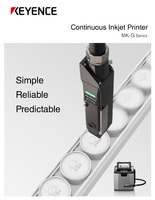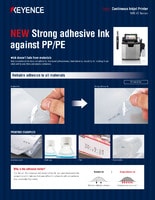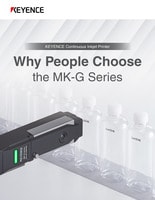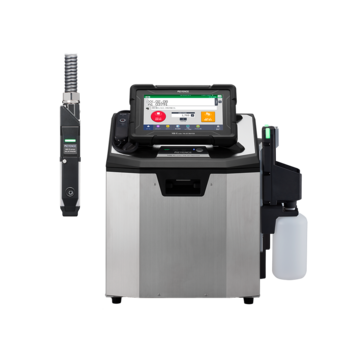Printing Lot Codes and Date Codes on Plastic Bottles/Containers
Cosmetics containers or other plastic bottles are date-coded while moving on a belt conveyor or in a bottle-filling machine. CIJs can print clear characters without flaws, even on curved surfaces. The printing content can be changed easily to support high-mix, low-volume production lines.
Date coding, also known as printing date codes on plastic bottles and other containers, is primarily linked to perishable items like food and beverages.
These codes are not limited to just expiration or packaging dates. They play a crucial role in conveying important information to consumers. Therefore, it is imperative for them to be not only legible but also durable enough to withstand storage, transport, and subsequent use.
Printing on plastic bottles is not always a straightforward task. The process itself presents a unique set of challenges, particularly when it comes to plastic beverage bottles. Additionally, there are other manufacturing obstacles that arise when printing on plastic containers.

PET bottles

Cosmetics containers
Challenges in Printing on Plastic Bottles and Plastic Containers
Challenges in printing on plastic bottles and plastic containers are mostly associated with the material properties of various plastics, certain laws and regulations surrounding plastic containers for perishable goods, and the manufacturing environments.
Plastic surfaces are often smooth and non-porous, which makes it incredibly difficult for ink to adhere to properly. Additionally, some plastic surfaces might be textured or even curved, which can also hinder printing or make the text illegible.
However, the most significant challenge in printing on plastic bottles and containers is ink adhesion. Certain types of plastics, such as poly-resins (PP, PE, HDPE) are notoriously difficult for ink to adhere to, which can cause printing issues such as smudging or fading over time.
To address this issue, KEYENCE has released a new strong adhesive ink printer: MK-G1000SA. This printer is specifically designed to ensure adhesion to all types of plastic materials, including poly-resins. With increased adhesiveness, heat tolerance, and durability for rubbing, the ink from this printer will not fade or smudge from plastic surfaces.
Lastly, printing on plastic bottles might require specialized ink or surface pre-treatment to facilitate ink adhesion and drying.
Reliable Adhesion to All Materials
Standard Ink

PP material film
Strong Adhesive Ink

PP material film
Advantages of Using Inkjet Printer for Plastic Bottles
Continuous inkjet printers for plastic bottles alleviate most of the challenges associated with printing on plastic bottles and containers, and they're typically most commonly used for printing text, such as expiration and packaging dates, as well as lot and date codes.
These printers are rather versatile, as they can use various types of ink, which additionally makes them suitable for printing on a wide variety of substrates. They're capable of producing clear and legible prints, ensuring readability and accuracy of the printed text or barcode.
They provide a non-contact printing method with plenty of customization and flexibility, which is great if your production line has to deliver small batches from time to time. CIJ printers are not only reliable, but they're also quite fast, with some models printing up to 500 meters of single-line text in as little as one minute. And they're quite easy and affordable to maintain.
Here are a few common applications using CIJ on plastic in the food, pharma, and cosmetics industries.
Printing on Plastic Film from a Vertical Form Fill and Seal Packaging Machine
An inkjet printer is used to mark best-by dates and lot numbers on the packaging films for snacks, frozen food, and condiments. When installed on a pillow type packaging machine or rotary filler, an inkjet printer can help prevent printing mistakes while improving manufacturing productivity.

Printing example

Installation example
Printing on Plastic Film from a Horizontal Form Fill and Seal Packaging Machine
Packets containing wet paper tissues can be marked by installing an inkjet printer on the pillow type packaging machine. An inkjet printer is ideal for printing on wet paper tissue packets due to its high speed printing capability as the packets flow rapidly through the packaging machine. A hot air blower may be used for quicker drying.

Printing example

Installation example
Printing on Plastic/Cardboard Packages on a Cartoner
The inkjet printer can be installed on cartoners for packing products into boxes. It even supports high-speed cartoners that produce up to 100 cartons per minute. Ink dries in a matter of seconds even on coated printing surfaces, providing clean, smudge-free marking on product boxes.

Printing example

Installation example
Bottom Coding the Underside of a Cosmetic Product Bottle on a Double Converyor Belt
An inkjet printer is used to mark best-by dates and lot numbers on container bottles for pharmaceutical and cosmetic products. By installing an inkjet printer on the conveyor belt carrying filled bottles, information can be marked on the curved side or bottom of the bottles, which are difficult to mark with stamps.

Printing example

Installation example
Printing on Plastic Bottles with a Filler
An inkjet printer is used to mark best-by dates and lot numbers on beverage bottles and other plastic bottles. By installing an inkjet printer on the conveyor belt carrying filled bottles, hundreds of bottles can be rapidly marked in a minute.

Printing example

Installation example
Printing on Plastic Containers and Caps with a Cup Sealer
Use the inkjet printer to mark best-by dates and lot numbers on pudding, yogurt, and jelly cups filled by a cup sealer or deep-drawing packaging machine. Products filled in parallel can also be marked by traversing the inkjet print head.

Printing example

Installation example
Print on Any Small Plastic Products with a Dedicated Conveyor Belt
For small lots that require printing, a simple set-up using our inkjet printer installed on the dedicated conveyor belt is very effective. A meter-long dedicated conveyor is a space-saving solution that can be laid out in the shipping zone.

Printing example

Installation example
Printing on Plastic Packaging Along with a Heat Sealer
A conveyor belt-type heat sealer is used primarily when manufacturing products in small lots. This naturally calls for more frequent changes in best-by dates. With an inkjet printer, users can quickly change the best-by date, which helps minimize the mistakes accompanying product changeovers.

Printing example

Installation example
Plastic Bottle/Container Inkjet Printer
KEYENCE's MK-G Series excels at printing on bottles and containers made out of plastic and several other substrates. In addition to being very versatile, the MK-G Series is exceptionally easy to maintain, thanks to the built-in self-troubleshooting feature, which significantly reduces downtime and cuts down on maintenance costs.
FAQs About Printing on Plastic Bottles
Is Inkjet Printing on Plastic Bottles Suitable for Food and Beverage Containers?
Yes, inkjet printing on plastic bottles is suitable for food and beverage containers, and it's widely used in the food and beverage industry. For indirect food contact printing, the U.S. Food and Drug Administration (FDA) requires a functional barrier between food and ink for any type of packaging, including plastic bottles. This means that the ink used for printing on plastic bottles must not come into direct contact with the food or beverage inside.
Can an Industrial Inkjet Printer for Bottles Handle Different Sizes and Shapes?
Yes, industrial inkjet printers for printing on plastic bottles are designed to handle bottles and containers of different sizes and shapes thanks to their adjustable print heads and generally fast changeover times.
Related Downloads
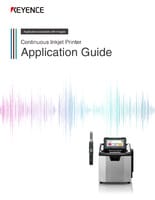
This guide explains continuous inkjet (CIJ) printer applications together with pictures and illustrations. It contains many installation examples in various industries divided into food, medicine, and cosmetics; electrical machinery and electronics; and automotive, metal, and others. These examples show printing on targets specific to each industry.

